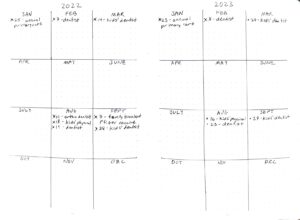My bullet journal has increased my mindfulness. I have tracked habits regarding exercise and study time, and trended stress levels and sleep quality. My journal is a place to collect the random thoughts that clutter my thinking. Writing in it is a meditation.
A bullet journal is much more than a sophisticated to do list. It’s a system that puts my tasks on autopilot so I can use my head space for creative and critical thinking. I can focus on what matters.
Start Your Own
Starting a bullet journal is simple. You need only two items: an 8×5.5″ journal with a dotted grid and a non-bleeding, fine-point (0.3 to 0.5 mm) pen. Ryder Carroll, the bullet journal’s creator, describes how to set up your bullet journal (BuJo for short) in his video.
Start with a title page and a page for your intentions for the journal. The following pages are the index, where you will reference the items in your journal by page number.
Next create your future log, where you can catalog tasks and events for future months. Information on facing pages is called a spread. Your first spread is your month view, with a calendar on the left page and to do list on the right. Each task is marked with a bullet in front. Finally, every day you will write a daily entry to collect your thoughts and lists in real time.
The magic happens when all the details of your life are logged, and you can begin to process them strategically. At the end of the weekend, I create a weekly page of events, and assign tasks from my monthly list to the day when they will be easiest to complete. At the beginning of each new month, I re-evaluate all uncompleted tasks and decide where to move them. The bullets make uncompleted tasks easy to find. I try to complete some immediately (draw an X through the bullet), but many will be copied into the next month’s spread (draw an arrow [→] through the bullet). Some won’t need to be addressed now, and I can free my mind by adding them to a future month in my future log.
Whenever I start a new monthly spread, I systematically review my goals and priorities. After copying items through several monthly cycles, the recognition of this pattern prompts me to take a closer look. Is the goal too large, abstract or not actionable? I may need to break it into smaller steps. Perhaps it isn’t the right time in my life to address something, and it needs to be added to my future log. Maybe the goal is an idea with merit but not worthy of my time and energy: With gratitude for this self-knowledge, I cross it out.

